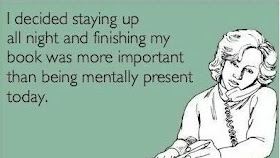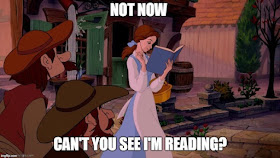Scene and chapter breaks are the most likely places to lose a reader. Are yours doing all they can to keep them reading?
On Monday, I talked about writing without chapters, and one of the benefits of that was choosing the best places to end my scenes and chapters. Today, I want to elaborate on that a bit.
When I was still new to writing, I thought a scene or a chapter was a contained bit of the story. It started, and then it wrapped up by the end. It might talk about what to do next, but that happened in the next chapter. I made the same mistakes pretty much every new writer does. I ended scenes with:
- Characters going to bed
- Characters setting off somewhere
- Characters achieving a goal and being happy about it
- Characters musing about the next day or the next task
- Obvious foreshadowing of doom (dum-dum-DUM!)
- Melodramatic cliffhangers with characters in trouble or shocking revelations
And that’s the whole point of a scene or chapter break.
I figured this out eventually, but there’s still something about the nature of a scene that makes you want to wrap things up, or end as the day ends, or stop when the interesting stuff stops. I’ve seen this often enough in other writers’ work to know it’s not just me.
The solution to this is simple:
Break your scenes and chapters where they have the most impact on the reader.
If you end the scene at a high-impact point, it will make readers want to keep reading to find out what happens next. Even if you write to a slow conclusion in the first draft, break scenes at the best moments during your revision.
And when you hit those really strong hook lines or perfect scene-ending moments—consider breaking the scene or ending the chapter there. Maybe you didn’t plan it, but it might be the perfect spot to hook readers and make them say, “Okay, one more chapter.”
Not every great hook line will work for the scene you’re writing, but it’s worth looking at. It’s not uncommon to write that great hook line, and then fill a paragraph or two with “wind down” information that kills the tension you just created. Characters retire for the night, they leave the premises, they bid each other farewell, etc. But the scene is usually stronger if we end on that hook.
(Here’s more on And...End Scene: When to Add a Scene Break)
Here are three ways to break your scenes and chapters for the most impact:
Break on the highest moment of tension.
Examine each scene. What’s the highest moment of tension in that scene? Can you end the scene or chapter there? If you change location or time right after that moment, a scene break is very possible. If not, this could be a good spot to end the chapter.
Oddly enough, readers have no problems with chapters ending and picking up with the next line, but they find it weird when scenes do it. A scene break typically means “something changed,” and that’s most often the location, time, or character point of view.
If the highest tension-moment doesn’t work, try the second highest, and keep looking until you find a better way to end than what you currently have (unless of course, it is the best already).
If you can’t find any high-tension moments, that’s a red flag your scene lacks tension, and a weak scene break probably isn’t the reason readers aren’t turning those pages. You might want to look at revising that scene to add more tension.
(Here’s more on Three Ways to Add Tension to a Scene During Revisions)
Break on a highly emotional moment.
Emotion is a big draw for many readers, especially in more character-focused genres. A character in the midst of a major emotional trauma or experience is a moment readers are not going to walk alway from.
Look at your scenes. What’s the most emotional moment? Where are the characters letting their feelings all hang out? Has anyone just faced a horrible situation that emotionally affected them in a significant way?
Next, consider how the story flows if you broke the scene or ended the chapter there. Does that emotional moment make readers want to stay with that character and find out how they handle those feelings? Would they worry (or anticipate) that the emotions might cause the character to act in a way readers fear (or hope) they might act?
If you have no emotional moments, that could be a red flag that the scene is too external, and you’re not letting readers into the heads of the point of view characters. This isn’t a problem if you’re writing in a plot-heavy genre, such as a police procedural—emotion isn’t why readers read those—but it’s a big issue if you’re writing romance.
(Here’s more on 5 Ways to Convey Emotions in Your Novel)
Break on a shocking discovery or revelation.
There’s a reason click-bait headlines work. People want to know things, and when interesting information is dangled before them, they usually grab it. This also works on readers.
Finally giving them a bit of information you’ve been teasing them with (or hiding from them), will likely make them want to know more, and they’ll read on hoping to get all their questions answered. You won’t do that yet, of course, but you can give them just enough to keep them wanting more.
Look for the moments in your story that reveal information readers have been waiting for. Also look for reveals or secrets they never saw coming. How does the story flow if you break the scene or end the chapter at that moment? There’s a good chance many of your scenes already end here, since this is a strong hook to end on.
If you have no shocking revelations or discoveries, that could be a red flag you’re giving readers too much information or being too obvious about what’s going on in the story. It might be too predictable with only one obvious path to take, so there are no choice for the characters to make, and thus no reason for readers to wonder what the characters are going to do.
Scene breaks and chapter endings are risky places in a novel, because it’s a natural place for readers to set down the book. But when we design those endings to keep readers reading, we can create a page-turner they can’t put down.
Do you plan where you end your scenes and chapters or do they just happen as you write?
Find out more about conflict, stakes, and tension in my book, Understanding Conflict (And What It Really Means).
 With in-depth analysis and easy-to-understand examples, Understanding Conflict (And What It Really Means) teaches you what conflict really is, discusses the various aspects of conflict, and reveals why common advice on creating conflict doesn't always work. It shows you how to develop and create conflict in your novel and explores aspects that affect conflict, as well as clarifying the misconceptions that confuse and frustrate so many writers.
With in-depth analysis and easy-to-understand examples, Understanding Conflict (And What It Really Means) teaches you what conflict really is, discusses the various aspects of conflict, and reveals why common advice on creating conflict doesn't always work. It shows you how to develop and create conflict in your novel and explores aspects that affect conflict, as well as clarifying the misconceptions that confuse and frustrate so many writers.This book will help you:
- Understand what conflict means and how to use it
- Tell the difference between external and internal conflicts
- See why conflict isn't a "one size fits all" solution
- Determine the type of conflict your story needs
- Fix lackluster scenes holding your writing back
Understanding Conflict (And What It Really Means) is more than just advice on what to do and what not to do—it’s a down and dirty examination and analysis of how conflict works, so you can develop it in whatever style or genre you’re writing. By the end of this book, you’ll have a solid understanding of what conflict means and the ability to use it without fear or frustration.
Available in paperback and ebook formats.
 Janice Hardy is the award-winning author of the teen fantasy trilogy The Healing Wars, including The Shifter, Blue Fire, and Darkfall from Balzer+Bray/Harper Collins. The Shifter, was chosen for the 2014 list of "Ten Books All Young Georgians Should Read" from the Georgia Center for the Book.
Janice Hardy is the award-winning author of the teen fantasy trilogy The Healing Wars, including The Shifter, Blue Fire, and Darkfall from Balzer+Bray/Harper Collins. The Shifter, was chosen for the 2014 list of "Ten Books All Young Georgians Should Read" from the Georgia Center for the Book.She also writes the Grace Harper urban fantasy series for adults under the name, J.T. Hardy.
When she's not writing novels, she's teaching other writers how to improve their craft. She's the founder of Fiction University and has written multiple books on writing.
Website | Facebook | Twitter | Pinterest | Goodreads | Amazon | Barnes & Noble | iTunes | Indie Bound




I'm not sure reader-me agrees with this: "readers have no problems with chapters ending and picking up with the next line”.
ReplyDeleteI do have a problem with chapters ending and picking up with the next line. I expect a chapter to end at the end of a scene, which means (as you've said), a change in time, place, or POV character.
Is it just me?
I doubt it. Different readers want different things, so I probably just haven't run into anyone who ever expressed that before :) I probably should add "usually" to that statement.
DeleteIf I remember right, chapters came from the old serials, where the story would end with a cliffhanger and pick up the next week at that moment. So the format stayed similar even though stories and novels evolved.
I'm also referring to endings designed to end on a high moment, such as "And suddenly, they heard a scream" type line, and then the next chapter opens with something like, "They raced into the yard..." So the scene might "end" so to speak with something dramatic happening, and the next chapter starts the new goal based on that ending.
Do those still bother you, or only ones where they don't really "end" they just break a section of text in half?
This is something I need to do. Thanks for this great tip, Janice!
ReplyDeleteThanks! That's what I'm revising to do myself right now, so it was on my mind, lol.
Delete